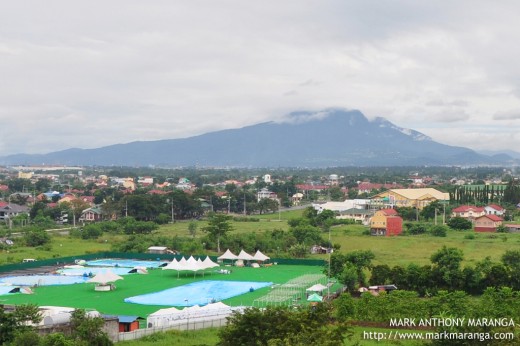Many regarded the Philippines as a volcanic country. Why? Simply because from the archipelagos 7,107 islands, soar more than 200 volcanic peaks and 18 of which are active such as Mayon Volcano in Albay, Mt. Apo in Davao and Mount Pinatubo in the intersection of the borders of Zambales, Tarlac and Pampanga.
One of the inactive volcanoes in the Philippines is Mount Makiling. Also called Mount Maquiling, it is situated in the province of Laguna and rises 1,090 meters above sea level. The forest found in Mt. Makiling is mainly lowland in type, with some montane forest around the peak above 900 m. The forest on most of the lower slopes has been cleared or degraded, but an area of good quality lowland forest remains around the botanic garden and the campus of the University of the Philippines Los Baños (UPLB). There are approximately 2,048 different species of plant.
According to PHIVOLCS (Philippine Institute of Volcanology and Seismology), Mount Makiling is an inactive volcano with no records of eruptions. It is showing no signs of imminent eruption although it has volcanic activity manifested by the boiling mud spring, the numerous hot springs in the area, and the geothermal resource on the mountain’s Batangas side.
The University of the Philippine Los Baños (UPLB) is assigned as the official caretaker of Mt. Makiling. Several types of agriculture can be found in the slopes of the mountain including a coconut plantations inter-cropped with coffees and fruit plantations mixed with pineapples and vegetables. The mountain also performs key ecological functions such as being a watershed and a sanctuary for wildlife.
Aside from the rainforest, Mount Makiling boosts several attractions like Makiling National Scout Reservation which is a campsite at the foot of the mountain, adjacent to UPLB managed by the Boy Scout of the Philippines and is the site used during the 26th Asia-Pacific Regional Jamboree in 2009 and 2010. You can also find the National Arts Center managed by the Cultural Center of the Philippines and the site of the Philippine High School for the Arts (a special school for young artist scholars) and the Pook ni Maria Makiling, an eco-tourism site adjacent to the Jamboree Site. The famous attraction in Mt. Makiling is the mud spring which has a maximum temperature of 80 degrees Celsius. It is the so-called ‘crater’ of the mountain where one could see pools of boiling mud.
Being a protected area, Mount Makiling has become a famous destination for mountaineers, scientists and tourists. There are three trails in climbing the mountain. The first and the frequently used trail is the UPLB route through the UPLB College of Forestry, the second trail is through Makiling Philippine Art’s Center which you can also access via UPLB and the last trail which is the most difficult and unestablished trail is the Sto. Tomas trail located at the other side of the mountain, in Sto. Tomas, Batangas.
Legends of Mount Makiling
The slopes of Mount Makiling are shaped to resemble a woman reclining, hence the air of mysticism that surrounds the mountain. Folklore about the beautiful siren and guardian of the forest, Maria Makiling had been told to generations. She was a fantastic creature, half nymph and half sylph.
According to one of the notable stories, Maria Makiling is a mystical-enchanted woman who lived in the woods at the foot of Mount Makiling. She was a young and beautiful woman with a kind and compassionate heart especially to the folks. She shares everything she has for free such as fishes in the lake, fruits, crops and food. She is very approachable that the people can reach her anytime on whatever they need. One afternoon, a hunter came across her kingdom and saw her. He fell in love with Maria Makiling and she too felt the same way for him. They talked everyday and promised to love each other forever. Until the day came that Maria waited for him but he never returned and she later found out that the hunter married a real woman. She was frustrated and deeply hurt that forgiveness was difficult for her to give. She then realized that she cannot trust the townsfolk because she was different from them and that they are just using her for their needs. Later on, the kindness in her heart turned into anger that she refused to give fruits and animals and fishes are vanishing. People seldom saw her that only during pale moonlight nights that they would sometime saw her.
Another story is about Maria Makiling and her three suitors battling for her love. One of her suitors, a Spanish soldier, another is a Spanish-Filipino mestizo and the last one is a Filipino farmer named Juan. Juan won the love of Maria Makiling and the other two suitors could not accept their defeat that they’ve plotted to kill Juan. A fire broke down on the fort which they blamed against the Filipinos including Juan. They shot him as a punishment and before dying Juan shouted Maria’s name. Maria heard Juan that she went down from the mountain and cursed them for not accepting defeat. She went back into the mountains and no one has seen her again. The Spanish soldier died in a revolution while the Spanish-Filipino mestizo died of illness. Now, when somebody gets lost in the mountain, people often attribute it to the curse of Maria Makiling.
This page is last updated on

 Mark Anthony Maranga is an Educator-Parent to his 3 Homeschooling Kids. He sells
Mark Anthony Maranga is an Educator-Parent to his 3 Homeschooling Kids. He sells 











another good destination for nature trip!